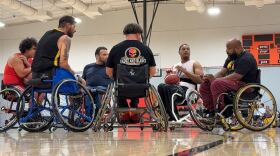New data show more than 23,800 students were homeless last year in San Diego County — a record high and a 4.7 percent increase over the previous year.
But a county Office of Education official acknowledges the homeless student count could be wrong. It all depends on who does the counting and how they interpret federal guidelines for calculating who is homeless. At stake is millions of dollars in federal funding.
“It's as accurate as whoever's counting for that district that year. I always look at the numbers as the best estimation we have,” said Susie Terry, who oversees foster youth and homeless education services for the county Office of Education.
The accuracy of each district’s count of homeless students heavily relies on the experience of its homeless student liaison, Terry said. That’s the individual responsible for enrolling and helping homeless students with such things as transportation to and from school and referrals for health services.
Under the federal McKinney-Vento Homeless Education Assistance Act, districts are required to report how many of their students are homeless, but how exactly they do that is up to them. The numbers are used by county education offices and school districts to apply for federal Education for Homeless Children and Youths Grants. In fiscal 2016, $70 million was available nationally..
In the last three-year grant cycle, more than $2.1 million was allocated to the Office of Education and three districts in the county — Vista Unified, San Diego Unified and Santee.
Homeless students made up 4.7 percent of the enrollment in San Diego County public schools this past school year. That means the students at some point during the school year were living unsheltered, in transitional housing or shelters, in motels or hotels, or most frequently, doubled up in a home with another family.
Those are the categories districts use to classify their homeless students, and that's where discrepancies occur — often in the counting of families living with others.
Of all homeless students identified in the county last year, 80 percent were living doubled up. The law requires districts to only count these students when the decision is based on financial hardship or loss of housing, not by choice. Determining that isn't easy.
“It's always an area that sort of stumbles a lot of districts,” Terry said. “Lots of families live together because that's what families do, especially in certain cultures.”
Defining ‘doubled up’
South Bay Union, a preschool through eighth grade district serving Imperial Beach, San Ysidro and south San Diego, had the second highest percentage of homeless students out of 42 districts in the county this past year.
Next year it expects to be far down the list because it changed the way it identifies students living in doubled-up situations.
“If families are doubled up, we ask the question: Is it due to hardship or choice?” said Pamela Reichert-Montiel, the district’s homeless liaison.
Before the current school year, the district’s enrollment paperwork identified all doubled-up students. Now, it prompts parents who say they are living with another family to choose whether they are doubled up because of economic hardship, sharing expenses or choice. Only those who choose economic hardship are counted as homeless.
Reichert-Montiel has previously said the district’s count of homeless students was “hugely inflated” because of this.
For example, it reported 1,611 students living as homeless in the 2016-17 school year — 93.5 percent, or 1,506 of them, were doubled up. But this year, the district has identified 315 students as homeless — an 80 percent decrease from the previous year — and only 232 are classified as doubled up.
DATABASE: San Diego County Homeless Students In 2018
Reporting fewer than 500 homeless students means South Bay Union would be eligible for about $150,000 over three years in McKinney-Vento grants compared to the $375,000 they were previously eligible for. The district did not receive funding in the last cycle.
The San Ysidro School District, a kindergarten through eighth grade district, has had the highest percentage of homeless students for more than five years. Last year, 1,507 — nearly 87 percent — were doubled up.
Veronica Medina, the district’s homeless liaison, said San Ysidro already asks families living in another family’s home what led to that. Is it by choice, to share expenses or out of economic hardship?
“We are trying to come up with a process to make sure that we don't over identify (homeless students) and don't under identify,” Medina said. “We still don't have an accurate count, but we’re trying to change the system. We do every year.”
Advocates for homeless students say it’s not the money related to these numbers that matters.
San Diego County tracks the number of homeless students who live unsheltered, in transitional housing or shelters, in motels or hotels, or doubled up. The following districts have the greatest share of homeless students in the county.
| Rank | District | Percent Homeless |
|---|---|---|
| 1. | San Ysidro | 36.01% |
| 2. | SDCOE/JCCS | 23.65% |
| 3. | South Bay Union | 21.84% |
| 4. | Fallbrook Union High | 15.77% |
| 5. | Bonsall Unified | 15.36% |
| 6. | Julian Union High | 15.33% |
| 7. | National | 14.69% |
| 8. | Vista Unified | 10.03% |
| 9. | Escondido Union Elementary | 6.62% |
| 10. | San Diego Unified | 6.11% |
“The benefit is to the student,” said Barbara Duffield, executive director of the nonprofit student advocacy group SchoolHouse Connection in Washington, D.C. “It's not about the numbers. It really isn't. The students that are identified have protections that kick in. They have services that kick in.”
Once identified as homeless, students are guaranteed immediate enrollment despite missing documents such as proof of residency or immunization records, and access to bus passes and after-school programs among other benefits.
“When they're identified, they can succeed and do better,” Duffield said. “If you turn a blind eye to that and don't appropriately identify these students, they're not going to get what they're entitled to out of their education.”
But monitoring of compliance with the McKinney-Vento law isn’t as frequent or thorough as it needs to be, Duffield said.
According to the U.S. Department of Education, states are responsible for data collection and determining whether districts are in compliance. But schedules from the California Education Department show that of seven districts in San Diego County being checked for compliance this upcoming year, none will be monitored for homeless education.
Getting help to homeless students
Terry with the county Office of Education said districts updating enrollment forms to improve the tracking of homeless students is common. But missing some of the homeless students in the count is a concern.
“My fear is that you can miss some families, too. Families need to understand why you're asking,” she said. “Most of us won't just naturally say, ‘Yeah, I'm struggling financially,’ to anyone, especially their kids’ school.”
Reichert-Montiel said after years of South Bay Union having one of the highest proportions of homeless students in the county, her district’s decrease is a positive step.
“I feel like now we have a better grasp in that it is more accurate of the families that are really struggling and are in need of additional services or support,” she said.
Regardless of whether districts receive a federal grant for homeless students, they still must provide homeless students with additional support when needed. For this, districts set aside funding in their regular budgets — often based on the number of homeless students reported.
Reichert-Montiel said she doesn't expect South Bay Union’s funding allocation to change because she has always known which students are “true homeless.”
“Students in shelters, students that are foster youth, students living in motels or in cars or campsites, those would be the students or the families that will walk in our doors for support. They would ask for bus passes or support,” she said. “A family that initially was doubled up for convenience or choice was not the family that was coming and asking for bus passes.”






